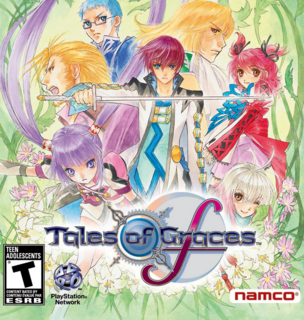Though not perfect, Tales of Graces f will please fans of the series, and is a solid game for any RPG fan.
Tales of Graces's opening sequence gives you the opportunity to play as protagonist Asbel Lhant as a child. A prologue of sorts, this opening serves to set the stage for the game's main story. In the few hours you play as the child version of Asbel, you befriend a prince, Richard, and find a girl with no memories, Sophie. Those familiar with JRPGs may be groaning at this rehashing of an old cliché, and there's no getting around the fact that it's been done to death. Sophie is charming enough right off the bat that it's not too hard to forgive this storytelling trope, and since the childhood characters don't take her memory loss too seriously, it's not hard for the player to treat it similarly. This prologue is paced somewhat slowly. It'll take a player three to four hours to complete it, but it feels like it should have ended between one and two.
The game's main story fires up seven years later, and the game's pace improves drastically at this point. The player is also given more combat options from this point forward, which makes the real-time battles much more enjoyable. The combat system is a little different than that of previous Tales game released in the US. All attacks, whether they're A Artes (standard attacks) or B Artes (special moves, such as spells) come from one attack gauge that refills very quickly when your character is standing still or blocking. The gauge is relatively small at first, but expands with each new weapon upgrade.
Standard attacks are much more varied and powerful now, compared to other games in the series, and spells come out much faster. Overall, the battle system is very fast paced. There is no customization of standard attack options, which could have added another level of depth to the game, but there are six different characters to choose from in the main game that allows for a good variety of gameplay options. Not all characters are created equal, but most are fun to use and it definitely keeps things interesting.
There are all sorts of little touches to keep combat interesting. There's pretty standard weapon customization available. It's unoriginal but passable, and can make weapons much stronger. Your characters also unlock various combat abilities and new moves through titles they acquire. While this may force you to peruse menus more often than you might like, it does give you a pretty big hand in customizing your characters. In addition to these touches, there's an "elith burst" mode in combat that allows you to chain an unlimited number of attacks and use special moves. You can also set a general strategy for your AI allies to follow, but this feels downgraded from a game like Tales of Vesperia, one of Graces's predecessors.
The game's story progresses at a pretty steady rate once you've gotten past the prologue, and stays interesting most of the time. There are some story bits that feel tacked on for the purposes of adding gameplay hours to the game, but it never feels out of hand. Story events and dungeons are separated evenly, and you never feel like the game is lagging. That being said, the overall dungeon designs are hit and miss. Some levels are awful, while some are genuinely interesting.
The story does feel like it bogs down at the end of the game, and then after defeating the final boss you're given the option to play Tales of Graces Future, which is an extra story mode that was added for the PS3 version of the game. It's short, but the extra hours are nice and there's an extra playable character for this portion of the game. That being said, the tone of Future is hokier than the game's original content, and this is a little off-putting at first. There are some attacks and events that can only be triggered in the Future part of the game, so make sure to get all those before you beat this part of the game. Afterward, you're sent back to end of the original story, where more bonus content awaits.
The graphics for the game are certainly not pushing any limits, but they're solid. You can definitely tell that the game was originally made for the Wii and then rereleased on the PS3. Still, the anime-inspired art works well, and while it may be that nothing will blow you away, the graphics are not bad enough to be a problem in any way. The music is similarly adequate. It's never bad, but never sticks out as being fantastic, either. It is definitely worth mentioning that the voice acting is good and fairly consistent. Some lines are delivered a little awkwardly, but on the whole the performance is good and believable. The writing is just as good as the voice acting, with the one possible exception being the somewhat unnatural shift in tone during the game's epilogue.
Overall, Tales of Graces f offers a strong story despite a slow start. Fast-paced combat and likeable characters enhance the player's experience. Small tweaks and improved graphics could have made the game better, but it's a good, challenging JRPG. You'll get fifty hours out of the main story and the epilogue alone, and there's plenty to do when the story is over. Tales of Graces f will please long time fans of the franchise while changing up enough things to make the series feel fresh and fun.

